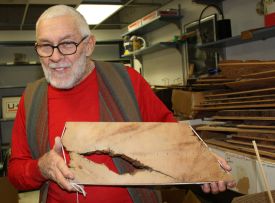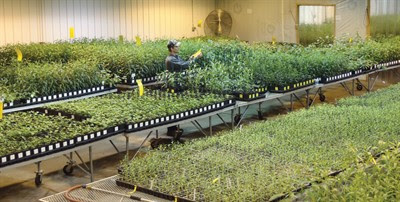Training with the Master- Experiences with Taika Seiyu Oyata
Signed Magazine article about Taika Oyata and his painful art. I love this picture, it's hard to fake real pain and completely unnecessary when training with Taika.
I am still training, I work out every day!
I started training in Ryukyu Kempo in 1986.
My first instructors were Greg Lindquist and Mike Whitney, out of their school in Overland Park, Kansas.
I caught the fever and never looked back. The mind and body numbing exercises, katas, kicks, punches, bag work, suburito drills(wooden sword), tuite-grappling, throws/pins, full contact fighting, weapons training and of course the kyusho-vital point striking. It was all incredibly new, excruciatingly painful ,very cool and highly addictive.
It all started for me with an advertisement for a martial arts tournament and demonstration.
A friend invited me to come see what he called "real Okinawan Karate" and a martial arts master demonstrating his techniques.
I had previously trained in Shotokan karate and had some Ju-jitsu and Judo training.
None of what I had seen or done previously prepared me for that fateful day.
*Rare ad for Master Oyata seminar-thanks to Greg Lindquist for this copy
I arrived to the demonstration in Independence, Missouri. The auditorium was packed, easily 200 people or more. I watched the competitions, katas and fighting. The full contact fighting, called Bogu Kumite, is another always painful reminder that no matter how good you are, there is somebody that hits harder, kicks harder, is faster or just meaner than you. What a wonderful, life affirming moment Bogu fighting is. Head and teeth jarring punches, kicks to all areas, arm strikes, elbows, sweeps-you get the picture.
Midway through the tournament, they announced the demonstration would begin.
The began to lay down large, thick mats on the gym floor.
A short, very powerfully built man stood in the center. He was introduced as Master Oyata and began to talk through an interpreter about his art.. He explained that real martial arts are not a trick or like the movies. It takes a lifetime to attain mastery of an art and it was important to have strong basic techniques and never stop training. He explained that in Okinawa, martial artists were held in high regard, most were of good, strong character. Helping their communities, the hidden protectors of the people'
He also explained more about his art: Tuite Jitsu- wrist and arm grappling, severely painful control and submission holds.
Kyusho Jitsu- Devastating nerve and pressure point strikes. He also went into a lot of detail about the meaning of the the word Jitsu- it means mystery or puzzle, an enigma or riddle that is either difficult or nearly impossible to solve.
At this point, he called out several people to the mats. He then began to tell his students/guinea pigs-
"Go ahead, punchee, kickee, doesn't matter "
The first man up towered over Mr. Oyata, he threw a wild punch that was stopped with a quick strike, he was hit in the neck 1/2 second later and crumpled to the ground in a heap.
The next instructor tried to do a spinning kick, Mr. Oyata quickly kicked the leg he was standing on out from under him, it was brutally efficient.
The techniques continued- he was knocking people out with neck strikes, wrapping people up in tuite/grappling and sending them screaming to the ground-it was awesome!
I had never imagined somebody was this skilled, he really was a Master!
Mr. Oyata then switched to weapons- he fought with a 6 foot staff, sai, jo and tonbo.
The best was for last- his cane technique. How deceptive an ordinary cane is! In the right hands, you can hook peoples arms, sweep their legs,hook their legs, hook their necks, shoulders, pin them on the ground and strike any number of ways. I was completely mesmerized by his mastery.
*The caption of this newspaper article says it all-I am lucky to have been his student!
Now comes the funny part. I waited until the end of the tournament/seminar and asked a few of the instructors if I could meet Mr. Oyata. They looked at me like I was crazy and said sure, he's around the corner smoking a cigarette. I walked out the door and there he was! I nervously introduced myself and thanked him for the demonstration. I told him how great he was, and I told him I wanted to train with him. He laughed at me!
His exact words were-"I don't think so"
He bluntly told me no,he did not know me, I was not good enough and would have to get a black belt in his system and then be invited for personal instruction, then maybe I could train with him.
He also told me-"you want to learn my karate, I kick ass" -Truer words have never been spoken.
I made my mind up right then, if it took 10 years, I would train in his system and eventually I could train with him-He was the only real martial arts master I had ever seen or met . There are a lot of posers and charlatans out there, none of whom were/are fit to shine Mr. Oyatas shoes.
*Mr Oyata also had no idea what a persistent, stubborn s.o.b. I am.
Because Mr. Oyata's Headquarters was based locally, I was able to attend seminars with him and actually tested for my Green Belt, and 3 degrees of Brown Belt in front of him.
You want to talk intimidating? You want some pressure in your life? Stand in front of a martial arts master, showing him your forms/technique while he is staring at you, unmoving, possibly unimpressed, 3 feet away.
You want more even more pressure? Test for Black Belt in front of Taika Seiyu Oyata, Albert Giraldi, Jim Logue, Steve Stark, Greg Lindquist and all the top instructors from around the country.
I trained with Mr Oyata at his Headquarterson on a bi-weekly basis for several years, then we all switched to weekly classes as his travels/seminars increased.
I trained hard and listened carefully to his instruction.
I wrote everything down!
I have several notebooks full of diagrams, techniques, excercises,
ideas about tuite, kyusho, kumiwaza and much, much more!
Enough for a book?
*Here is a photo of my ShodanCertificate-1st Degree Black Belt
This is a blurry shot of my Yondan Certificate-4th Degree Black Belt
I am not overly concerned with Black Belt ranking. I have 2 scrolls from Taika Oyata in his family art- Oyata Shin Shu Ho Ryu. I'm not going to photograph them or reveal what rank comes with them. Other than my wife and son, they are my most treasured possessions, because they were given to me by Mr. Oyata and because of what they represent:
I have always held my teacher and his art in the highest regard.
Oyata Shin Shu Ho Ryu-
"Strive to attain true moral goodness and express it through one's every action":












































